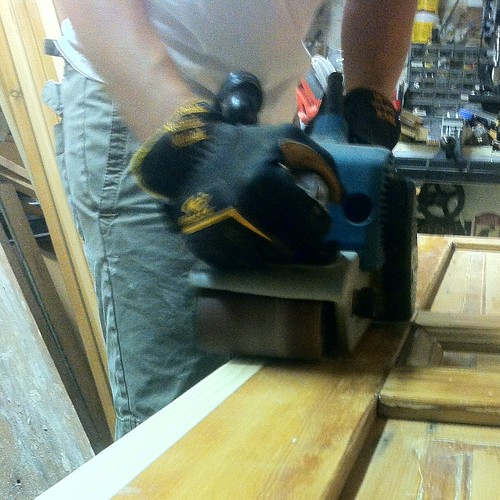Two weekends ago I once again needed to use my belt sander. This time it came in handy when removing glue and excess material on the joint of the new extension piece on the front door. The sander performed perfectly and made quick work of the task, leaving us with a very smooth joint that you will never know is there once it's painted. Because of the right tool, I was able to quickly and easily knock this item off of our list, but it wasn't always this simple to sand something smooth.
Up until a year and a half ago, I didn't own a belt sander. I viewed the tool as a luxury that I simply didn't need and couldn't justify purchasing. If I had a ridge, board, or joint that needed to be sanded I would break out the random orbit sander and some 40 grit paper. If it was a severe case, I might use the hand plane first, then the sander. This left me with many instances where I would sand for what seemed like hours only to put a small dent in the task.
This tool deficiency changed a few years back when I was custom cutting some door jambs our bedroom. The jambs had to match the original jams in the house, which meant I needed to cut them directly from stock 4/4 lumber. Unfortunately, the lumber yards don't keep old jamb sizes in the inventory anymore. I ended up using my table saw and dado blade to remove the material, but that left small ridges in the wood.
After struggling with the hand plane and sander, I decided I had far too much to tackle and it was a good excuse to buy a belt sander. I looked around on a few tool review websites, read several reviews from Amazon users, and saw an article on fine woodworking that did a belt sander roundup.
From all of the various input I reviewed, I determined that a Makita brand sander was the tool for me. It seemed to have the reputation for quality and reliability I was looking for, and had a good selection of different sanders to choose from.
I ended up purchasing the 4" 11amp sander based on several different critical decision points. First, I wanted a sander that had a wide enough belt to handle the various materials I would throw at it. Second, I wanted a sander with sufficient weight, one that would be able to do the majority of the work on its own without the need for me to really push down on it, since that just causes damage to the wood. And third, I wanted a sander that had a good dust port to hook up to a dust collection system/vac. The 4" sander met all of these needs without issue.
Once I received the sander, I was pleasantly surprised by how easy it was to change the belt and calibrate it for my needs. It was also exceedingly easy to hook up to the dust collector with a simple flexible shop vac host to replace the Makita dust collection bag.
I've used this sander on several projects since I purchased it, and it has worked well every time. The weight is substantial but not overwhelming, and the width of the sanding belt has worked well for all of my applications. The one problem I've had was with the black handle on the front. For some reason the glue on the handle failed and the top half of it came off from the bottom half. This was solved with a little bit of duct tape, no big deal.
I just wish I had this sander when I realized the stain I had applied to the top of our desk was the wrong color and had to sand it off. I think I spent three hours and about two dozen sanding discs to get the wood back to a point where we were able to stain it again. But hey, live and learn. And hopefully our experience can help you avoid a similar situation.
Did you enjoy reading this post? Want to learn more about our first-hand experiences with other tools, devices or items used throughout our renovation? If so, check out our complete list of product reviews in our Toolbox Tuesday section.
Note: We weren't compensated for this review. We simply want to share good products when we see them, and hope that learning from our mistakes can help save you time, money and frustration.

![]()
![]()